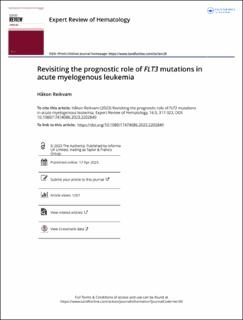| dc.contributor.author | Reikvam, Håkon | |
| dc.date.accessioned | 2023-10-18T09:01:43Z | |
| dc.date.available | 2023-10-18T09:01:43Z | |
| dc.date.created | 2023-06-21T12:32:21Z | |
| dc.date.issued | 2023 | |
| dc.identifier.issn | 1747-4086 | |
| dc.identifier.uri | https://hdl.handle.net/11250/3097213 | |
| dc.description.abstract | Introduction: Approximately one-third of patients with acute myelogenous leukemia (AML) harbor mutations in the fms-like tyrosine kinase 3 (FLT3) gene. The features regarding prognostic impact of FLT3 mutated AML have been widely investigated and debated in the last decades, and the significance of this mutation is constantly evolving.
Areas covered: In this article, the significance of the FLT3 mutation and various aspects of this mutation are discussed in the light of new understanding and research progress in past years. The recently updated European Leukemia Net (ELN) guidelines are reviewed and discussed, special emphasis given to the the improvement in therapeutic approaches for FLT3 mutated AML.
Expert opinion: Aspects related to FLT3 mutated AML include the type of mutation in addition to FLT3-internal tandem duplication (ITD) length, location, and allelic ratio. Furthermore, the coexistence of cytogenetic variants and molecular genetic mutations utterly complicate the evaluation of the prognostic impact. In addition, introduction of FLT3 inhibitors and establishment of measurable residual disease (MRD) monitoring have entered the treatment and evaluation armamentarium in the handling of AML patients, resulting in improved prognosis for these patients. However, future research to optimize the treatment of FLT3 mutated AML is highly desired. | en_US |
| dc.language.iso | eng | en_US |
| dc.publisher | Taylor & Francis | en_US |
| dc.rights | Attribution-NonCommercial-NoDerivatives 4.0 Internasjonal | * |
| dc.rights.uri | http://creativecommons.org/licenses/by-nc-nd/4.0/deed.no | * |
| dc.title | Revisiting the prognostic role of FLT3 mutations in acute myelogenous leukemia | en_US |
| dc.type | Journal article | en_US |
| dc.type | Peer reviewed | en_US |
| dc.description.version | publishedVersion | en_US |
| dc.rights.holder | Copyright 2023 the authors | en_US |
| cristin.ispublished | true | |
| cristin.fulltext | original | |
| cristin.qualitycode | 1 | |
| dc.identifier.doi | 10.1080/17474086.2023.2202849 | |
| dc.identifier.cristin | 2156566 | |
| dc.source.journal | Expert Review of Hematology | en_US |
| dc.source.pagenumber | 317-323 | en_US |
| dc.identifier.citation | Expert Review of Hematology. 2023, 16 (5), 317-323. | en_US |
| dc.source.volume | 16 | en_US |
| dc.source.issue | 5 | en_US |

